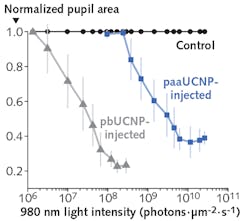IR Upconversion Imaging: Upconversion nanoparticles in eyes enable mice to see infrared—may work for humans, too

No mammalian eyes can naturally see past the visible spectral region into the infrared (IR). The visible region is often defined as 400 to 700 nm, although the human eye has a low and declining, but real, sensitivity to light out to 780 nm (and a little beyond that, if you’re willing to look at laser light intense enough to damage your eyes). The evolutionary reason for this drop in spectral sensitivity is that, for mammalian opsin-based receptors, the lower energy of IR photons would require a lower energy barrier in the opsin, which would end up boosting the relative thermal noise energy too high for practicality.
As for artificial digital imaging, there is a technique called upconversion IR imaging, in which the imaging system uses nonlinear optics to shorten the wavelength of the IR light, allowing less-costly cameras to do the imaging.
Now, a multidisciplinary group of researchers led by Xue and Jin Bao at the University of Science and Technology of China (Hefei, China) as well as Gang Han at the University of Massachusetts Medical School (Worcester, MA), have developed a simple way to enable mammalian vision in the near-IR out to 1000 nm, using upconversion imaging—and have tested it successfully on mice.1 The approach they take is quite simple: they inject photoreceptor-binding upconversion nanoparticles (pbUCNPs) into the eyes of mice so that the particles are near the retina.
The particles, which are 38 nm in size and made of the ytterbium- and erbium-containing nonlinear optical material β-NaYF4:20%Yb,2%Er@β-NaYF4 fabricated in a core-shell structure, convert light with a peak wavelength of 980 nm to light with a 535 nm peak. The researchers determined that the particles bind to glycoproteins in the retina’s photoreceptors.
Only one injection needed
A single injection of nanoparticles in the mice’s eyes bestowed IR vision for up to 10 weeks with minimal side effects, allowing them to see IR light even during the day and with enough specificity to distinguish between different shapes. Mice that received the injections showed unconscious physical signs that they were detecting IR light, such as their pupils constricting, while mice injected with only the buffer solution didn’t respond to IR light (see figure).
To test whether the mice could make sense of the IR light, the researchers set up a series of maze tasks to show the mice could see IR even in daylight conditions, simultaneously with visible light.
The researchers believe the biointegrated nanoparticles are desirable for potential IR applications in encryption, security, and military operations. “In the future, we think there may be room to improve the technology with a new version of organic-based nanoparticles, made of FDA-approved compounds, that appear to result in even brighter infrared vision,” says Han, who notes that they will also be tailoring the IR excitation wavelength in these newer nanoparticles.
The nanoparticle-based vision-enhancement approach could potentially be useful in civilian encryption and device identification, security, military operations, and human-machine interfaces, say the researchers, and could possibly also be used to repair visual function.
REFERENCE
1. Y. Ma et al., Cell (2019); https://doi.org/10.1016/j.cell.2019.01.038.
About the Author
John Wallace
Senior Technical Editor (1998-2022)
John Wallace was with Laser Focus World for nearly 25 years, retiring in late June 2022. He obtained a bachelor's degree in mechanical engineering and physics at Rutgers University and a master's in optical engineering at the University of Rochester. Before becoming an editor, John worked as an engineer at RCA, Exxon, Eastman Kodak, and GCA Corporation.
